Collecting Springerle and Speculaas information please!
I have collected Butter molds, stamps ect. for many years. During a recent search on Ebay, I came across some butter/cookie prints very similar to a large butter box type mold. Of course I was hooked right away! I have a few books from amazon, in German of course. Very fun translating them. I recently purchased a large board which I would call a speculaas, it was white washed, (ugh) but very primitive. I know that some of the earliest molds were very intricate, and of course there would be different styles from Germany, Switzerland etc. I also know there were many periods of reproductions of the original molds, such as the wax impressions. My question is, I cannot find very much information on when the wax reproductions began, and when or where the very intricate hand carvings of the molds progressed to a more naive carving, to an even awful rendition in the 1950-1970's. Any expert opinion would be great! As there are no Engish books on the subject, evasive suggestions on the internet of reproductions except for the present companies that produce beautiful replicas in a resin and wood composite. Picture is of a long board, not as intricate as some I have seen, has and old chain to hang by. Any ideas of age would be great. Debra
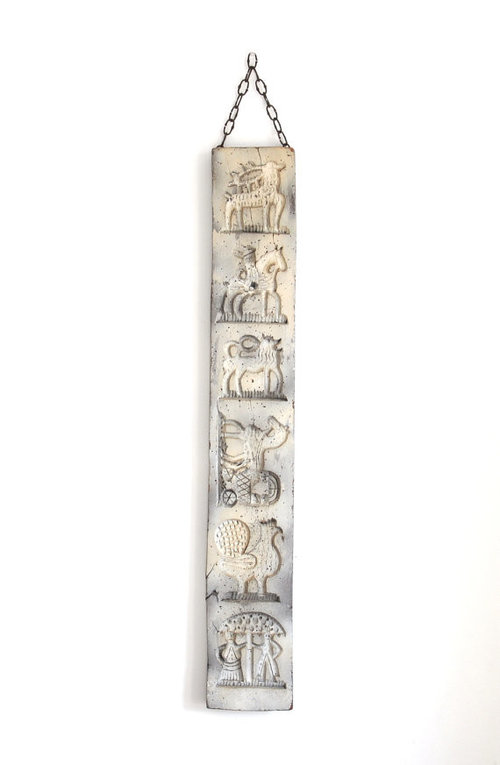
Comments (24)
lindac92
7 years agoI don't know a thing about wax impression reproductions. And the words "speculaas" and "springerle" refer to the cookies not the molds. They are properly called "springerle molds"...or cookie molds.
I live very near Pella, a very Dutch community and cookie molds have been used there for years....a grandpa carved one for his grand daughter when she was a bride....not to say that she used it but he gave it to her..LOL!
Not sure there were "periods" of styles, complicated vs naive....I think it depended on the carver.
And Springerle cookies are usually imprinted with a rolling pin. The board molds were used for a shorter cookie. have you ever made springerle?
I found lots of info about cookie molds and cake molds...linked below is one example.
Carved cookie and cake molds have been made for hundreds of years.
http://newsok.com/article/2121204Debra Vessels
Original Author7 years agoThank you lindac92. Very interesting article. No, I have never made Springerle. cookies, I don't bake anymore, and I understand it is quite a process, or an art to make a good tasting cookie with a good impression of the mold. The second mold is bees wax, replicated from an original wood mold. The carvings of the original wood mold were very intricate. The third picture is a mold of mine that is a little less intricate, I would say it was made in the late 1800's. The first picture is a reproduction from the 1950-70's. This is what I meant by more naive, which probably isn't the best word to describe it. Thank you for your input.
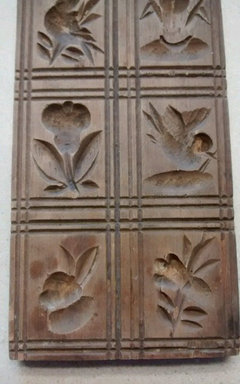
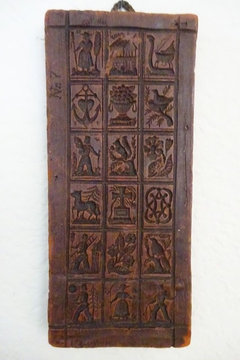
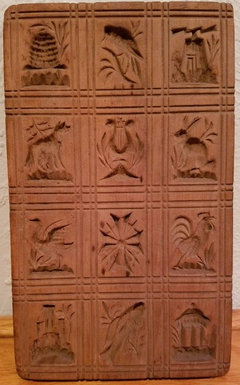
lindac92
7 years agoSpringele are very easy to make...it's an eggy sweet dough, but getting a good impression is something else!
I just roll them out and cut into squares.....the taste is the same.
I suspect that the more elaborate cookie boards were made as an example of the carvers art....because a very intricate design will "bake out"...it's the simpler ones that stay in the baked cookie.Debra Vessels
Original Author7 years agoI have read that you should let the cookies dry before you bake them, that helps to keep the print. I may try them at Christmas time. I surely will not use the old molds though. I will make gingerbread cookies for the Grandkids, and I used to make shortbread cookies at Christmas using my butter stamps.
sheilajoyce_gw
7 years agoI learned to bake springerles about 1950 when my aunt introduced them to our family. I have used 2 different recipes, one of which is much easier to work. You make the dough, roll it out into a rectangle rather thickly with a plain rolling pin, and then slowly and firmly press the springerle rolling pin along the dough. Trim the square pictures and carefully place them an inch or two apart on a greased cookie sheet that is sprinkled lightly with anise seed. Let them sit overnight so that the pictures will dry and set up. Bake the next day, and do not store with other cookies or they will all taste like anise. For the younger children, we bake a few trays without anise. I like to eat springerles freshly baked, but the correct way to serve them is a few weeks later when they are dried throughout. Not for me. Fresh is good.
lindac92
7 years agoLove old aged springerle!....dunked in tea?
you let them dry over night before baking and they develop a sort of glaze on top.
Yum!fredda501880
7 years agolast modified: 7 years agoSheilajoyce_gw How thick is rather thickly, that you roll with the regular pin? Thanks, fredda---Also, would a sugar cookie dough work?
lindac92
7 years agoRoll to about 1/4 inch thick> Sugar cookies won't work because of the shortening and the leavening...
lindac92
7 years agoUse springerle dough for springerle cookies>
http://allrecipes.com/recipe/150123/traditional-springerle/smbetz
7 years agoDebra, I would love to know what books you have found. I know so little German that all I have been able to do is use Google to translate a single paragraph or a caption on a photo. I have had a long-term interest in objects used to shape cookies, though I am not an expert. That said, I will jump in and make some comments.
Your Speculaas board probably would not look so primitive without the white wash. It looks quite typical of historic Dutch speculaasplanken I have seen in the Netherlands that make cookies for individual servings. Because the dough and method are so different Springerle stamps can have much finer detail which will be reflected in the final cookie. I will say I have found many more flat boards for Springerle over the years than I have rolling pins for same. The pins certainly do make mass production easier, however, and for a home, the rolling pin gives many images on one tool - another bonus.
The few wax reproductions I have seen have been from the mid-1900s but their designs have sometimes been from centuries ago.
Lindac92, do you have a list of the info you have on cookie molds and cookie stamps? I have some info, too, and it might be worthwhile to share.
Fredda, if you like the taste you can certainly use a shortbread-like dough (no leavening) with simpler cookie stamps. Think of the ceramic ones by Rycraft for example. It's a fun project with children - Wilton made a whole series of plastic stamps over the years often with character themes. The thistle designs on larger wooden shortbread molds make a great statement, too.To fit the theme of the web site, I should say that I have many of my stamps and molds and even copper cutters decorating the walls in my kitchen and dining room.
Debra Vessels
Original Author7 years agosmbetz, The first book I ordered was from SpringerleJoy.com. It is "Anismodel", by Linus Feller. A beautiful book, and it came with a 24 page printed English Translation. The molds are mostly Swedish. From Amazon I ordered " Stolze Reiter, schone Damen" by Christa Fischer, German. Both were well worth the money for me, as I enjoy researching as much as I do collecting molds ect. Yes, Online translations have been a big help, and since these are my books, I have written in pencil some of the translations. The pictures in both books are amazing, and both have pictures of the white Anise cookie, also, some of the cookies are painted, which is very interesting. I also have a great buttermold book by the Van Vurens, which shows an Advertisement from Richardi & Bechtold having a large woodenware factory in Bellaire, Missouri 1880, lasting 25 years. The ad shows their "fancy cake prints" springerle molds, of all styles and sizes of boards and rollers. Having traveled to Germany in 1884 to hire a master carver to run this department, and bringing back, Robert Duderstadt, from Halberstadt to emigrate to Bellaire. I believe many of the rollers and prints we find on Ebay today from that period, could be from this company.
The prints and rollers produced by "House on the Hill are pricey, but are a resin based mold, so it would be very food safe. The rollers sell for over $100.00. The antique rollers on Ebay are pricey, some 2-300.00 and up. I was lucky to find a very nice one in my $50.00 price range.
I also thought my Speculaas board would be dutch. I have since carefully removed the paint, with a spray citrus remover, fortunately, the paint was only lightly spray painted and was not embedded in the carving or worm holes. The patina is still wonderful and I coated it with beeswax butcher block conditioner, as I do all of my wooden items. Being in the Southwest, very hot and dry I like to preserve this way.
I have been collecting everything to do with butter making for over 30 years, displayed in my kitchen and pantry, these cookie boards and molds fit in perfectly.
Thank you everyone for your responses. Debra
smbetz
7 years agoDebra,
thank you for the lead on the ad in the Van Vurens book; I have just ordered a
copy. I only have a few butter molds
along with Paul Kindig’s book and a couple pamphlets and hadn’t come across the
book you mentioned.Yes,
Feller and Fischer’s books are very worthwhile.
Did you mean Swiss when you said Swedish for the molds in Feller’s book? If not, please explain why you think the
molds are Swedish because that wasn’t my reaction. If you get serious about cookie boards, you
will also want to possess works by J. J. Schilstra and Edith Hörandner
among others. Here are my recommendations
(copied from my bibliography):Hörandner, Edith.
Model: Geschnitzte Formen für Lebkuchen, Spekulatius
und Springerle (Molds: Carved Forms for
Gingerbread, Spekulatius, and Springerle).
Munich, Germany: Callwey, 1982. In German.Schilstra, J. J. Prenten in hout - speculaas, taai- en
dragantvormen in Nederland. Lochem,- In Dutch.
If you haven’t noticed yet, Spekulatius is the German
equivalent of Speculaas (Dutch) and Speculoos (Belgian and Flemish). Same type of spiced molded cookie often with
negative space like the first mold you showed.And, I understand dry. I now live in an area of California where it
is hard to wash windows because they dry so quickly.Debra Vessels
Original Author7 years agoWow smbetz, you are the expert I was looking for! I think between Paul Kindigs book and the Van Vurens, pretty much covers the butter molds. The Van Vurens is a little different as it covers manufactures in order. The two together are about the only two that really give you all of the books that are available. The others are like a carbon copy of each other, meaning Trice, which are good books, but not much history. At first I wasn't too impressed with the Van Vuren's but the amount of research was enormous. The more I go back to it for information, the more I love it. I hope you enjoy it. Paul Kindigs is wonderful for pictures ect., but don't you think a lot of his European molds he has pictured were cookie molds as opposed to butter molds? Not being an expert, that is just an opinion. I will look for the books you have suggested, I have only purchased the ones available from Amazon, and the Anismodel. I am not sure why I came to the impression the molds were Swiss and not German. I really haven't had time to study it. Your opinion is greatly appreciated. My interpretation so far is that the smaller more intricate molds with many small motives are Springerle molds and the large molds, like the one I have are Speculass, and yes, I gathered the different spellings in different languages. I will learn. I think the large board is the only one I will purchase, when it arrived, my husband asked me what I bought, I replied, a big piece of wood! LOL I love it, as it has all of the motives I like. I love the rooster and rider, but have not found one yet I am willing to pay for, except a wax mold with a rooster and riding squirrel. I love the sense of humor in it. I also have an affection for the Wrapped Infant. I am almost Leary of the wax molds in my climate, but they are affordable. And they are as beautiful as the original wood, almost! I look forward to learning and collecting. I will make shortbread or gingerbread for Christmas. My husband made copper ginger bread men 30 years ago, I love to use those. The grandchildren love them. Anise cookies, maybe. Thank you for all of the information. I only wish I could read German. Debra
smbetz
7 years agoYes, Debra, I do agree that there are items in Paul Kindig's book that have been misidentified and are not butter molds.
You can sometimes find the foreign books on the Amazon web sites unique to those countries. I have ordered that way without any problems. Just use Google Translate for a few key words; you will find that the web pages follow the same pattern as US Amazon web site. Of course, shipping can be more than the cost of the book so check carefully before committing to a purchase. And be prepared to wait longer for the delivery.
Keep in mind that there are other molded or stamped cookies like Shortbread, Tirggel, Couques de Dinant, and Pryaniki (and all the various spellings). A way to differentiate boards for Springerle from those for Speculaas/Speculoos/Spekulatius is that items to make Springerle are stamps. That is, you press the board or roll the pin onto the usually already rolled out dough. The designs for Springerle are more detailed because of the type of dough and the drying time. As a caution, really detailed multi-image carved boards without borders between images may well be for sugar work and not cookie dough.Speculaas and other honey-sweetened or spiced doughs are shaped by forming the dough in the depression of a mold. One method is to roll or pat the dough to about the size of the image and then press it into the mold. Done that way it is usally easier to release the cookie as you haven't put a lot of pressure on the dough trying to spread it. Think of stamps as having shallower carvings and molds having deeper ones with shaped edges. Some molds, for Pryaniki for example, may be deep enough to have a filling (Gevulde Speculaas is another example). Not too long ago I got a lovely hand carved wooden snow maiden mold from Russia that I look forward to using with a recipe for Pryaniki.
Debra Vessels
Original Author7 years agosmbetz, I was able to purchase the Hörandner, Edith. Model: book from Abebooks, UK. It will ship from Germany. The cost plus shipping was less than what I paid for the Fischer book from the US. It should arrive in a month. I have ordered books and many antiques from the UK, so I always check shipping first. That should give me enough books to translate this winter!
The Pryaniki recipe sounds very good and not too difficult.
Gargamel
7 years agoThis was the most interesting post I have ever read on Gardenweb. Thank you all for the wealth of information you've shared.
jennifersaks
6 years agoFor any of you who are wanting more information re: Springerle baking, there is a very good Facebook group. Lots of recipes, hints, tips, and connections to various mold carvers, etc.
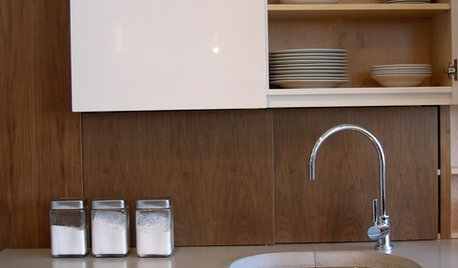






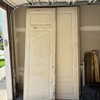
sheilajoyce_gw